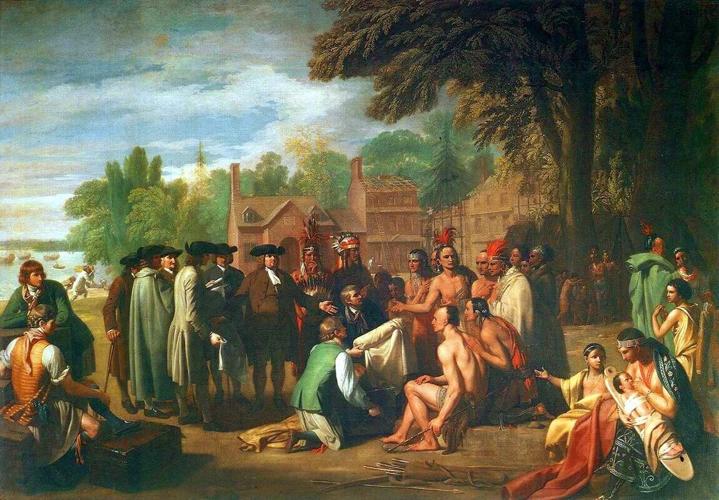
Benjamin West's painting, 'The Treaty of Penn with the Indians' depicts William Penn negotiating with Chief Tamanend, known today as St. Tammany.
His name was Tamanend. Chief Tamanend.
Tammany for short.
That probably came later as people found his name rolled off their tongues easier with a "y" at the end. Either way, he's still the same person, and his only Louisiana connection is that he has a parish named for him.
Which is a pretty big deal given that St. Tammany isn't really a saint. Well, not in the official Catholic church capacity.
That's something Maxine Rappold of New Orleans had already figured out when asking who, exactly, was St. Tammany.
"I'm guessing St. Tammany wasn't a real saint," she said.
It was his reputed benevolence that won him the nickname of "saint" in life.
Tamanend was the chief of the Turtle Clan of the Lenni-Lenape nation of American Indians in the Delaware Valley at the time Philadelphia was established. According to the Delaware Tribe of Indians at delawaretribe.org, Tamanend "is best known as a lover of peace and friendship who played a prominent role in the establishment of peaceful relations among the Native American tribes and the English settlers who established Pennsylvania, led by William Penn."

Philadelphia's monument to Chief Tamanend, sculpted by Ray Sandoval, stands at the intersection of Front and Main streets.
Tamanend did this by signing a peace treaty in a meeting between the leaders of the Lenni-Lenape nation and the leaders of the Pennsylvania colony beneath a large elm tree at Shakamaxon in the early 1680s.
"There, Tamanend is reported to have announced that the Lenni-Lenape and the English colonists would 'live in peace as long as the waters run in the rivers and creeks and as long as the stars and moon endure,'" delawaretribe.org states. These words have been memorialized on the statue of Tamanend that stands in Philadelphia today."
The statue stands at the intersection of Philadelphia's Front and Market streets with the inscription, "Tamanend was considered the patron saint of America by the colonists prior to American Independence."
"He was regarded as the person that kind of sold the land to them," said Sam Hyde, director of the Center for Southeast Louisiana Studies at Southeastern Louisiana University in Hammond. "So, basically they made a cult figure out of him, kind of a folk hero. By legitimizing the land sale, he appealed to American nationalism."

A detail shot of Philadelphia's monument to Chief Tamanend, sculpted by Ray Sandoval, stands at the intersection of Front and Main streets.
Again, that's in Philadelphia. The chief who would be saint had no connection to Louisiana. So, how did he earn the honors of being the namesake of a Louisiana parish?
"Basically, let's say it's kind of a very American story," Hyde said. "They kind of used him to legitimize the taking of the land in Pennsylvania, and William C.C. Claiborne wanted to make people in the area identify as Americans, so he uses this folk figure to do it."
Claiborne was Louisiana's first governor, serving from April 30, 1812, the day Louisiana was the 18th state admitted to the Union, to Dec. 16, 1816. St. Tammany Parish had been a part of the West Florida Republic until the United States annexed the territory in 1810.
Thomas Jefferson had doubled the size of the United States by signing the Louisiana Purchase in 1803, but Spain opted to hold on to the West Florida Republic at that time.

Chief Tamanend is depicted in the 42nd New York Infantry Monument at the Gettysburg Battlefield.
"It was strategically important to Spain, and it just deepened the mass of people pouring into that area, especially British loyalists who were being picked on and persecuted on in the Carolinas and areas," Hyde said. "They flocked to the region as one of the closest spots they could find that was not controlled by the Americans."
But with the United States' eventual forced annexation, Claiborne knew he would have to do something to prompt West Floridians' assimilation into their new country.

Commercial photographer Irving Underhill's image of Tammany Hall on East 14th Street in Manhattan, which featured a white marble statue of Tamanend located in the arch on top of the building.
"The area was forcibly taken, and Claiborne realized there was just no support for the Americans here," Hyde said. "So this was a strategic decision on his part to use the name of St. Tammany, who's this folk figure, and he names the region that. It becomes the only Louisiana parish who has a patron saint that has nothing to do with the Catholic church."
Claiborne's strategy was to make the people in the area identify as Americans at a time when most were reluctant, if not outright hostile to doing so.
As for Tamanend, St. Tammany societies popped up throughout the country, the most famous being New York City's Society of St. Tammany, whose members developed the influential political machine known as "Tammany Hall."
The Continental Congress, when meeting in Philadelphia in 1777, voted to set aside May 1 as St. Tammany Day. On that day, John Adams wrote to his wife Abigail, "The people have sainted him and keep his day."
Curious Louisiana is a community-driven reporting project that connects readers to our newsrooms' resources to dig, research and find answers about the Pelican State. Bottom line: If you've got a question about something Louisiana-centric, ask us.





